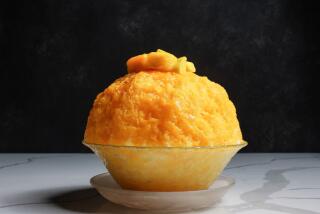When Dessert Was Medicine
- Share via
We love dessert. We expect dessert. If we don’t get something sweet after dinner, we feel as if, well, we’ve been sent to our rooms without dessert.
But we don’t expect it at lunch, and we never have it at breakfast. And a sweet dessert is not typical of non-European cuisines. There’s no such thing as a dessert course in China, where sweets play a very small role in the cuisine. The Middle East is famous for its pastries, but they’re not meal-enders; they’re something you eat during the day with coffee.
In fact, a sweet dessert is not universal even in Europe. At the end of dinner, the ancient Romans thought of apples, and many modern Europeans think of fruit or cheese. So where did the idea of a sweet dessert come from?
From the medieval banquet, which typically ended with a spiced wine drink called hippocras and perhaps some candied spice seeds. The essence was the spices, which were intended to improve the digestion (like the fennel seeds people chew after a meal in India today), because a banquet was so much richer than an everyday meal.
This happened right after the table was cleared. “Dessert” comes from desservir, which means more or less to un-serve in French, referring to the removal of the dishes and the tablecloth and perhaps even the table itself. (Medieval banquet tables were merely planks laid on sawhorses.)
In the Renaissance, dessert became more and more elaborate--and sweet--and banquets ended with spectacular creations of sugar and pastry. When the price of sugar declined, the practice filtered down to ordinary folks, and that’s how we got dessert.
The medieval dessert of a drink and some little sweets is still with us, by the way. After a dinner party, we still like to have a drink (nowadays perhaps a decaf coffee, rather than a beaker of hippocras) and an after-dinner mint.


